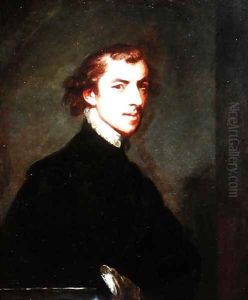George Huddesford Paintings
George Huddesford was an English satirical poet, painter, and cleric born in 1749. Although he is not as widely recognized as some of his contemporaries, Huddesford made a modest contribution to the cultural landscape of the late 18th century. He was the son of George Huddesford, the President of Trinity College, Oxford, and his upbringing and education were deeply rooted in the academic environment of the university.
Huddesford initially studied at Winchester College before going on to attend New College, Oxford, where he obtained a Bachelor of Arts degree in 1772. He pursued a career in the church and was presented to the living of Warton in Lancashire in 1777. Huddesford's career, however, was not solely confined to ecclesiastical pursuits. He had a keen interest in art and literature and was connected to the literary and artistic circles of his time.
In the field of art, Huddesford is known to have been a student of Sir Joshua Reynolds, the prominent English painter and President of the Royal Academy. Under Reynolds' tutelage, Huddesford developed his skills as a portrait painter, though his artistic output did not achieve significant recognition.
As a writer, Huddesford is remembered for his satirical verses. His most notable works include 'Salmagundi', a satirical poem published in 1791, and 'The Bulls, Bears, and Dogs of London', published in 1799. These works, along with others such as 'Topsy Turvy' and 'Warley,' display his penchant for satire and reflect the influence of Alexander Pope, a master of the satirical verse in the previous century. Huddesford's satires targeted the social and political issues of his time, often with a sharp wit.
Despite his endeavors in art and literature, Huddesford did not achieve widespread fame and his work was largely forgotten following his death in 1809. Nevertheless, his contributions provide a glimpse into the satirical discourse of the late 18th century and the literary circles within which he moved.


